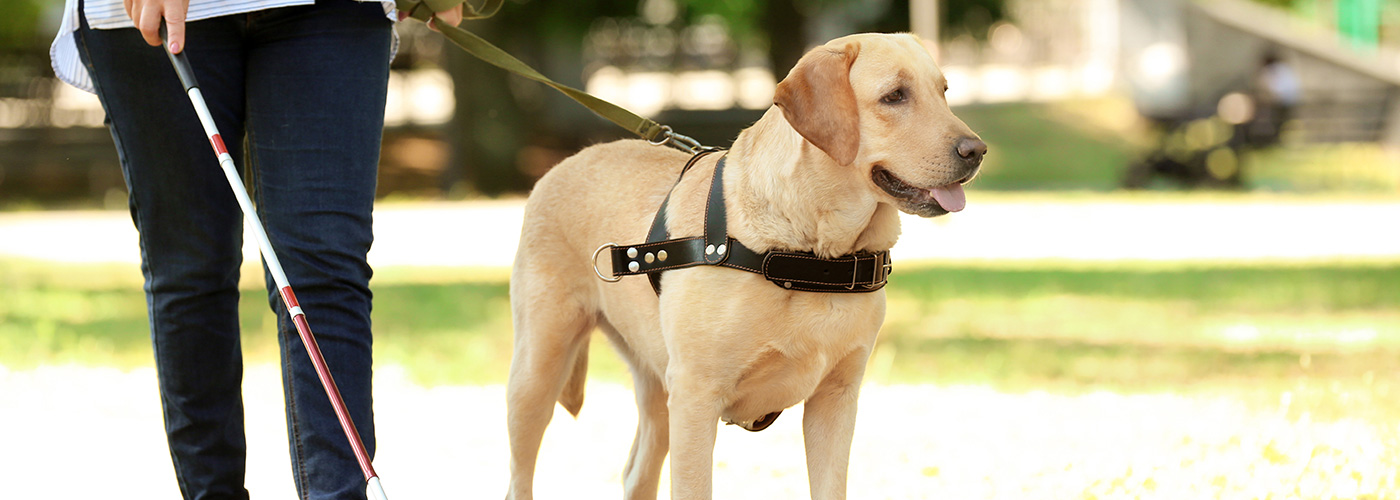Service dog etiquette

Picture this: you're strolling down the street, listening to music when you see a person walking their Labrador Retriever. The canine has a harness that reads "SERVICE DOG." While many of us know that we shouldn't touch a service dog, our first instinct may still be to say hi, wave, or try and get its attention.
Even though these actions may seem harmless, they are really distracting and dangerous. Service dogs have a very specific and special job for their owners. Distractions can not only create anxiety for the owner but can also keep the dog from performing its job in a potentially lifesaving situation.
Below, we will cover some important tips for how you can interact with these special canines -- both in and out of the workplace.
A distraction-free work zone
Service dogs go through rigorous training to provide support and companionship to a person with a disability. During the process, they learn commands and become socialized to the many settings they will be exposed to. When service dogs wear their harnesses, also referred to as capes, they are focused on assisting their owner. Even if a dog is laying on the ground, or seems to be resting, it is still "on-duty," listening for changes in heartbeat or breathing and staying hyperaware of its surroundings.
Actions by an individual that could break the animal’s concentration include making eye contact, talking, whistling, cooing, and calling the dog by its name. When in doubt, ask the owner if you can pet the dog and respect their answer. While some might say yes, many will instead need their companion to stay focused on the task at hand.
Just like people, service dogs have off-duty lives, too, filled with play time and love.
Service dogs in the workplace
In a work setting, team members might need to interact with a co-worker and their service dog more frequently. Even in these situations, it is still important to ask the owner for permission to interact, even if the dog tries to get your attention. While it may be tempting to give this furry companion a treat, you should avoid doing so. Aside from creating a distraction, service dogs are usually on a strict diet and feeding schedule and can have allergies that you may not be aware of.
It's important to avoid asking co-workers intrusive questions about their disability, or why they need a service dog. Having a service dog is not an invitation for a conversation, just a medical necessity for the individual.
Instead of asking why your colleague needs their dog, ask if there is a particular way you should interact with them both while you’re working together. This will allow you to respect their boundaries while creating an inclusive and mindful workplace environment.
Helpful do's and don'ts
| Do's | Don'ts |
|---|---|
| Whether a service animal is wearing their harness or not, do ask the owner if you can pet or interact with the dog | If a service animal if wearing a vest, don't create any distractions |
| Pay attention to the owner | Don't make eye contact with the dog and ignore the individual |
| If you're at work, do ask how you can respect boundaries | Don't make a service dog the center of the conversation |
| Be respectful of medical conditions | Don't ask questions about the individuals' disabilities or why they need a service dog |
| Educate your family, friends, and those around you | Don't let children, pets, or other family members interact with a service dog without permission |
While this article offers suggested guidance, it is always advised to check with owners of service animals about their preferences. Through education, we can create a more inclusive society -- giving individuals with disabilities, and their furry companions, the respect and support they need.
To learn more about SourceAmerica, please email customerservice@sourceamerica.org.
Special thank you to Claire Stanley, Advocacy and Outreach Specialist at the America Council for the Blind, for her input on this story.
Enjoy this? You might like these stories, too: